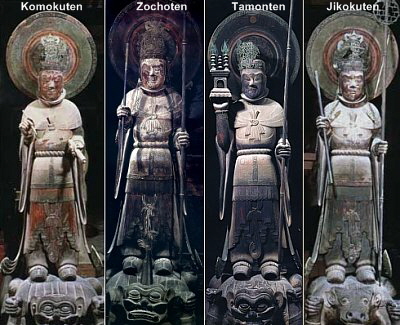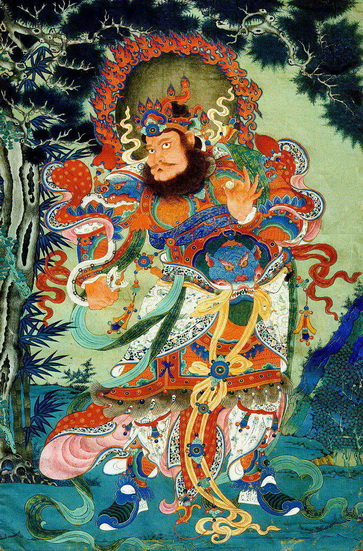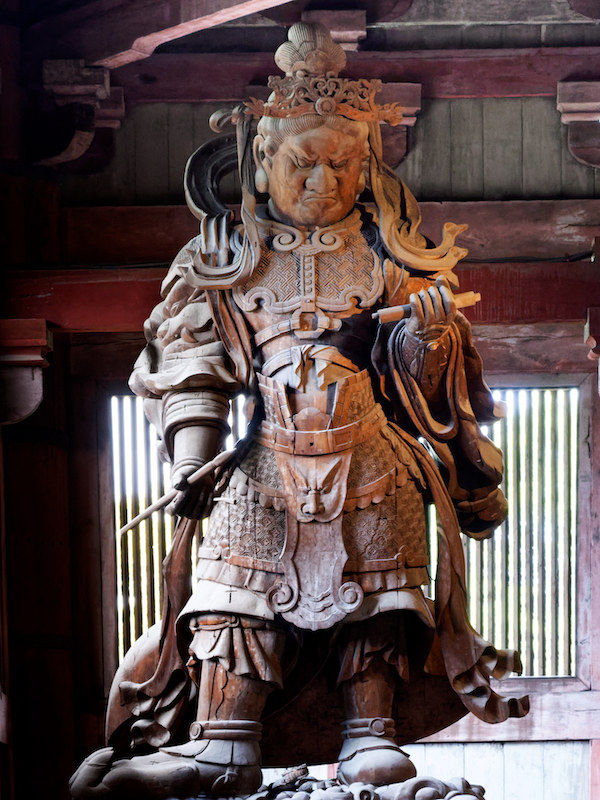FEATURES|COLUMNS|Imagery and Iconography (inactive)
The King of the West: Kōmokuten Iconography

The Four Guardian Kings at Hōryū-ji, seventh century.
From onmarkproductions.com
The Four Guardian Kings (Skt: caturmaharaja; Jpn: shitennō) are counted among a category of Buddhist deities called celestial beings (Skt: deva; Jpn: tenbu). Although Hindu in origin (as lokapala), they were enticed and adapted into the Buddhist pantheon to serve and protect. Their role as “gods” does not spare them from the cycle of rebirth, as they are still mortal beings. However, their lives span a period of 500 years, with each celestial day encompassing 50 human years. Each of these is dedicated to the protection of the Buddhist heavens and of the sangha, especially those of the latter who recite and keep the teachings of the Lotus Sutra and Golden Light Sutra.
As protector deities subservient to a central figure—namely Sakra (an epithet of Indra; Jpn: Taishakuten), the lord of the devas—the Four Heavenly Kings dwell on the slopes of Meru, the great mountain at the center of the Buddhist cosmos and home of many Buddhist deities. Each safeguards a directional continent as the chief of an army of terrifying creatures: Vaisravana (Jpn: Tamonten) protects the northern continent Uttarakuru (Jpn: Hokkurushū) as the head of yaksa (Jpn: yasha) and rakshasa (Jpn: rasetsu); Dhrtarastra (Jpn: Jikokuten) protects the eastern continent Purvavideha (Jpn: Tō Shōshin Shū) with gandharva (Jpn: kendatsuba) and pisaca (Jpn: bishasha); and Virudhaka (Jpn: Zōchōten) the southern continent Jambudvipa (Jpn: Nansenbushū) with kumbhanda (Jpn: kubanda) and preta-gati (Jpn: gaki).
The western continent, called Aparagodaniya (Jpn: Saigokashū), falls under the care of Virupaksa (Jpn: Kōmokuten). His legion consists of naga (Jpn: ryū), the great dragons and serpents of both Hindu and Buddhist Indian mythology, which dwell beneath the ocean and control the tides, the flow of rivers, and the rain, and of putana, a type of hungry ghost associated with pestilent disease.

Virupaksa holding snake and pearl.
From chinabuddhismencyclopedia.com
One apocryphal story tells how Virupaksa, a garuda in a previous life, attacked two sea-dwelling naga with Vaisravana, also a garuda. Try as they might, the two could not harm the naga because, as the serpents soon revealed, they had taken shelter in Kashyapa Buddha and were thus protected by their newfound virtue. This convinced the two garuda to do the same and the four vowed to be reborn at the time of the historical Buddha so that they might protect him.
Virupaksa, guardian king of the west, discerns and punishes evil while simultaneously encouraging those who aspire to enlightenment. His name translates to “Wide-eyed” or “Expansive Vision,” which refers to his preternatural ability to see all within and without the Dharma. He is often depicted with red skin and holds a pearl in one hand and a snake in the other, though sometimes the snake is instead coiled around his body. The pearl represents consistency and the snake the changing of the environment; together they speak to Virupaksa’s gift of clear vision, which helps practitioners see through the turmoil of change.
In certain regions of China, Virupaksa is known as Mo-li Hai, the “Far-Gazer.” His face, blue in color, wears an expression of discernment as he simultaneously contemplates not only his immediate surroundings but the conditions of those whom he is required to protect. He carries a four-stringed Chinese string instrument that can affect earth, fire, water, or air, and, when played, can capture the attention of the entire world.

A towering Kōmokuten at Tōdai-ji, 17th century restoration. From wikipedia.org
Kōmokuten, whose imagery entered Japan at the same time as that of the other members of the shitennō, is there associated with the season of autumn, the element of metal, and the color white. While wearing similar Chinese-style armor (Jpn: yoroi) and expressing the same fearsome visage (Jpn: funnusō) as the other three kings, he treads upon demons (Jpn: jyaki) to further assure Buddhist adherents that evil is of no concern to them; it is kept at bay by the shitennō. Kōmokuten sometimes wields a three-tipped spear (Jpn: sansageki) which, as in his role of protecting the Thousand-armed Kannon, may extend beyond his full height. Other times, such as with certain Gohonzon in Nichiren Buddhism, he holds a jewel and a snake. His stare is fixated on the jewel so that its intensity does not kill weaker beings.
The king of the west is most commonly depicted, however, holding a brush in one hand and a rolled sutra in the other. These remind the Buddhist faithful that contemplation of the Buddha’s sermons in their entirety—whether in silent meditation, earnest recitation, or intent copying of the sutra (Jpn: shakyō)—can destroy the obstacles to enlightenment. Notable portrayals of Kōmokuten can be seen at Hōryū-ji (seventh century), in the Kaidan-in of Tōdai-ji (eighth century), and Tō-ji (ninth century), and his cult persists into the modern day as one of the major guardians of Buddhist deities and of the Japanese nation.
Related features from Buddhistdoor Global
The King of the South: Zо̄chо̄ten Iconography
The King of the East: Jikokuten Iconography
King of Kings: The Propagation of Bishamonten Iconography
Protected on All Four Sides: The Propagation of Guardian King Iconography
Origins of the Godai Myо̄о̄
More from Imagery and Iconography by Michael Van Hartingsveldt














